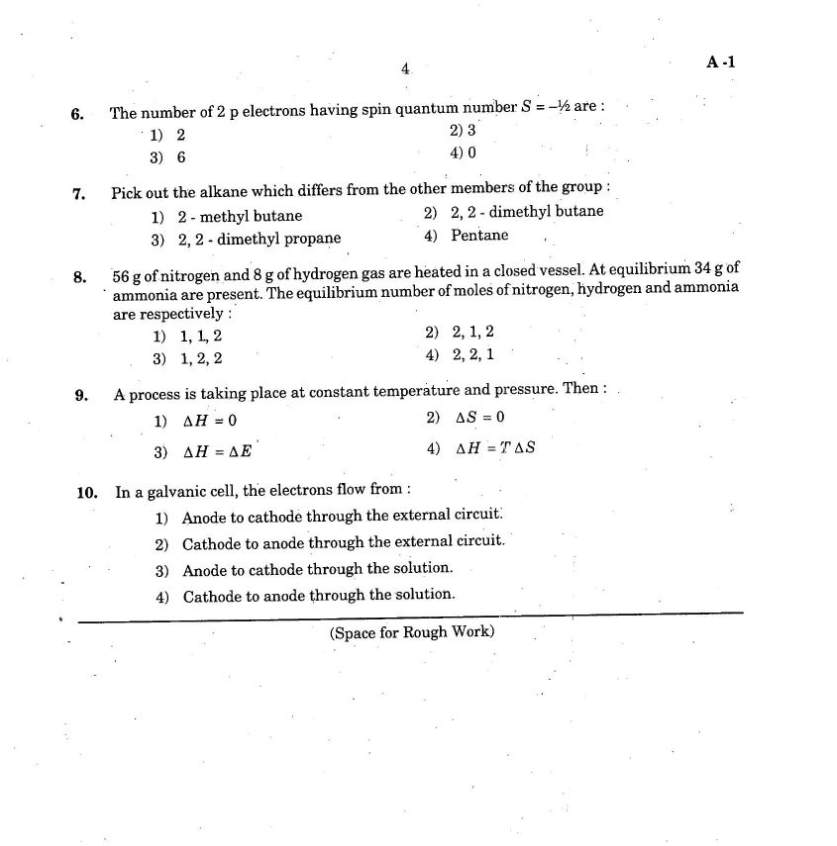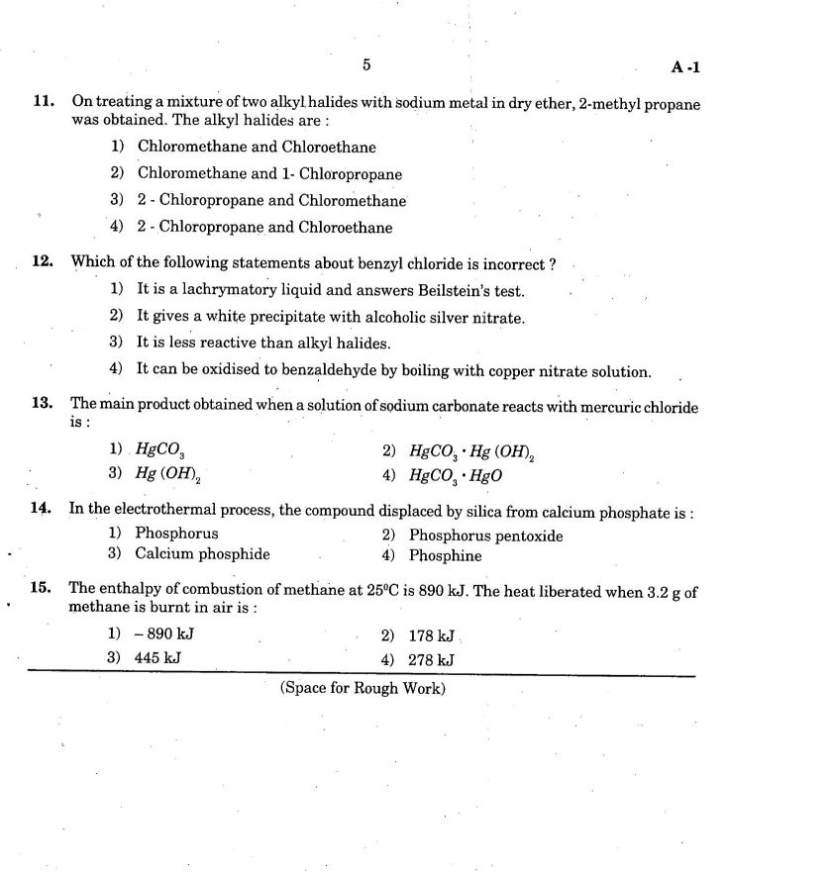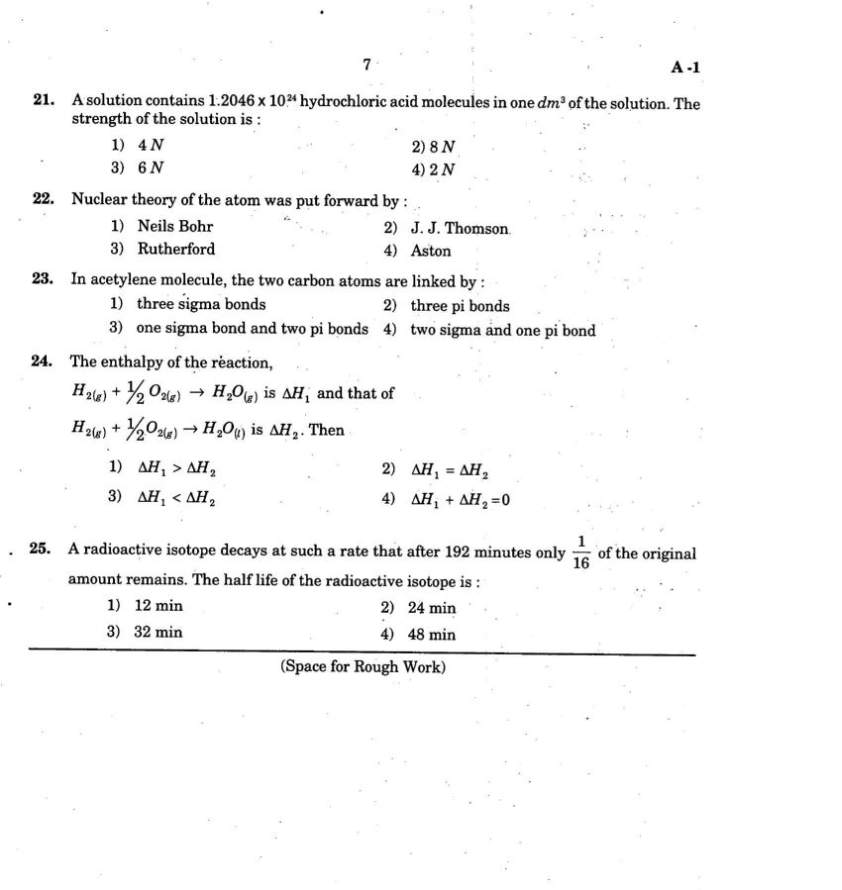|
#1
| |||
| |||
|
Give me information about the previous year question paper for the PGT chemistry examination organized by the Kendriya Vidyala Sangathan ?? KVS PGT Chemistry Last Year Papers       Here I am giving you information about the previous year question paper for the PGT chemistry examination organized by the Kendriya Vidyala Sangathan in a PDF file with it .. Syllabus for PGT chemistry :: Syllabus for written examination for PGT(CHEMISTRY) Topic (Details of the syllabus) Some Basic concepts of Chemistry: Scope of chemistry- Historical approach to nature of matter – states of matter, properties of matter and its measurement, S. I system of units, Uncertainty in measurements, dimensional analysis, Laws of chemical combination, atomic and molecular masses, Mole concept and molar masses, percentage composition, empirical and molecular masses, equivalent weight, concept of limiting reagent States of Matter: Gases, liquids and solids, three states of matter, types of intermolecular forces. The laws governing ideal gas behaviour, Dalton’s law of partial pressure, Kinetic molecular theory of ideal gases, Maxwell Boltzmann distribution law on molecular motion, real gases – deviation from ideal behaviour, vander Waals equation. Liquid and their properties. Solids: Classification of solids, fundamental types of lattices, two and three dimensional lattice types, Simple crystal structures, Transformation of crystal structure on varying temperature, Bragg’s law, density in solids, energy band, band gaps, semiconductors, magnetic and dielectric properties, stoichiometric and non- stoichiometric defects in solids. Structure of Atom:Structure of Atom (Classical Theory), Dalton’s atomic theory, Bohr’s model of atom, Structure of atom (modern theory), de Broglie’s relationship, Heisenberg’s uncertainty principal, Classical wave equation, Schrödinger’s wave equation, Probability distribution curve, Quantum numbers, Pauli’s exclusion principle, Aufbau principle, Hund’s rule of maximum multiplicity. Equilibrium: Reversible reactions, criteria of equilibrium, Law of mass action, equilibrium constant, Kc and Kp , Le Chatelier principle, Ionic equilibrium, Ostwald’s dilution Law, solution of acids, bases, ionic equilibria in solution, Common ion effect – its application to qualitative analysis, acids and bases, Bronsted- Lowry theory of acids and bases, Lewis concept of acid and bases, relative strengths of acids and bases, their quantitative estimation, buffer solution and its use, determination of pH, theories of indicators, conductometric titration, Solubility product, hydrolysis. Surface Chemistry:Adsorption, absorption, sorption, Physical adsorption, Chemisorption adsorption, isotherms ( Freundlich, Langmuir), application of adsorption, types of Catalysis theories of catalysis, classification of colloids, preparation of Colloidal Solution (lyophobic and lyophilic), Special characteristics of colloidal solutions , electrophoresis, Precipitation of colloids – Hardy Schulze law, multimolecular and macromolecular colloids, Emulsion and Gels. Chemical Kinetics: Theories of reaction rates, rate of reaction , molecularity and order of reaction, Fast reactions- Luminescence and energy transfer process, reaction mechanisms(Simple and complex reactions). Redox Reaction and Electrochemistry: Oxidation and reduction, redox reaction and its application, oxidation number, Strong and weak electrolytes, activity coefficient, conductance and conductivity, Kohlrausch law, resistance and resistivity molar conductivity, equivalent conductivity, Qualitative and quantitative aspect of electrolysis, electrochemical cell and electrolytic cell, Electrode and electrode potential and standard electrode potential, Electrochemical series and its applications, Nernst equation and its application, Equilibrium constant and EMF of the cell. Solutions:Solution and its types, expression of concentration of solution, solubility and factors affecting the solubility of a solid in a liquid (temperature and pressure), Vapour pressure of a liquid, Raoult’s law for both volatile and non volatile solute,Ideal and non ideal solution, Colligative properties, abnormal molecular masses and Van’t Hoff factor. Chemical bonding and Molecular Structure: Valence electrons and Lewis structures, Ionic bond, Covalent bond, Bond parameters ,Co-ordinate bond, polarity and dipole moment, Quantitative idea of – valence bond theory, molecular orbital theory (LCAO), Concept of hybridization involving s, p, d orbitals, Hydrogen bond, Resonance. Thermodynamics:Macroscopic properties of the system, modes of transfer of energy between system and surrounding, Phase transition, phase rule and phase diagram, First Law, second law and third law, of thermodynamics. Internal energy and enthalpy of the reaction, their measurement and application, spontaneity of process, Entropy and spontaneity, Helmholtz and Gibb’s free energy, Thermodynamics of electrochemical cells. Classification of elements and periodicity in properties: Significance of classification, brief history of the development of periodic table, periodic laws, name of the elements with Z>100 according to IUPAC system, classification of elements into s, p, d, f –block elements and their characteristics, Periodic trends in the properties of elements – Ionization enthalpy, Electron gain enthalpy, electronegativity, atomic radii, ionic radii, periodicity of valency or oxidation state. Hydrogen:Position of Hydrogen in periodic table, occurrence, isotopes, Preparation of hydrogen, on small and commercial scale, hydrides, water, hard and soft water, heavy water, hydrogen peroxide, hydrogen economy, hydrogen as a fuel. General principles and processes of isolation of elements and s – block elements: Principles and methods of extraction, oxidation and reduction as applied to the extraction procedures of Al, Cu, Zn and Fe. s – block elements, general introduction – Electronic configuration,occurrence, Anomalous properties of the first element of each group, diagonal relationship, Trends in variation of the properties, reaction of alkali and alkaline earth metals. Preparation and properties and uses of some important compounds: – sodium carbonate, sodium bicarbonate, sodium chloride, sodium hydroxide, calcium hydroxide and calcium carbonate, industrial uses of lime and lime stone, biological importance of sodium, potassium, magnesium and calcium. p – Block Elements: Electronic configuration, variation in physical and chemical properties of groups 13 to 18, physical and chemical properties of borax, boric acid, boron hydride, silicones, preparation and uses, preparation, properties and uses of nitrogen, ammonia, nitric acid and oxides of nitrogen, phosphorus – allotropic forms, preparation and properties of phosphine, phosphorus pentachloride and phosphorus trichloride, preparation, properties and uses of oxygen and ozone, hydrides and halides of 16 group elements, their structure and nature, allotropic forms of sulphur- their preparation, preparation, properties and uses of sulphur dioxide, industrial preparation of oxo-acids of sulphur, preparation and properties of halogen and halogen acids, inter halogen compounds, pseudohalide ions. Oxo-acids of halogens, their structure and nature, preparation, properties and uses of xenon fluorides, oxides of xenon and xenon oxo fluorides. The d – and f- Block Elements: General introduction, electronic configuration and general trend in the properties of first row transition metals like metallic character, ionization enthalpy, oxidation states, ionic radii, coloured ion formation, catalytic properties, magnetic properties, oxides, halides and sulphides of first row transition metals, complex compound formation etc. Preparation, properties and structures of KMnO4 and K2Cr2 O7, lanthanoids and actinoids. Co-ordination Compounds and organometallics: Meaning of co-ordination compounds, Werner’s theory, ligands – their types, IUPAC nomenclature of co- ordination compounds, isomerism, bonding in co-ordination compounds, colour, magnetic properties and, stabilities of co-ordination compounds. Chemical and biological importance of co-ordination compounds, metal carbonyls: preparation, properties and bonding, organometallic compounds and their classification. Organic Chemistry : Some Basic Principles and Techniques: General Classification of organic compounds, Shapes of organic compounds-Hybridisation(sp, sp2,sp3), Structural representation of organic molecules, Functional groups, Homologous, series. Common or trivial names, nomenclature of aliphatic, aromatic and substituted aromatic compounds. Isomerism : Structural and Stereo isomerism Fundamental Concepts in Reaction Mechanism: Cleavage of covalent bond, Types of attacking species, electron movement in organic reactions, electronic displacement in a covalent bond and types of organic reactions. Methods of purification of organic compounds: Qualitative analysis, Quantitative analysis., estimation of the elements and determination of empirical and molecular formula. Hydrocarbons: Classification of hydrocarbons. Alkanes: Conformations (Newmann and Sawhorse formulae), Physical properties, Chemical reactions Cycloalkanes: Preparation, physical and chemical properties, stability of cycloalkanes(Bayer strain theory), chair and boat forms of cyclohexane. Alkenes:, structure of double bond, geometrical isomerism, physical properties, methods of preparation, chemical reactions. Alkadienes: Classification of dienes, Preparation of conjugated dienes, Chemical properties(1,2 and 1,4- addition to conjugated dienes). Alkynes:, structure of triple bond, physical properties, methods of preparation Chemical properties, Acidic nature of alkynes Aromatic Hydrocarbons:, Structure of benzene, resonance, aromaticity (Huckel’s rule) Chemical properties, mechanism of electrophilic substitution direct influence of substituents in monosubustituted benzene. Environmental Chemistry: Environmental pollution, Atmospheric pollution, Tropospheric pollution(Air pollution), Major air pollutants, Control of air pollution, Smog(Chemical and Photochemical smog), Stratospheric pollution: Ozone layer and its depletion, Acid rain, Green House Effect and Global warming, Water pollution, Soil pollution and Industrial waste. 20. Haloalkanes and Haloarenes: Classification, methods of preparation of haloalkanes and haloarenes, their physical properties, tests to distinguish between alkyl and aryl halides, mechanism of SN1 and SN2 reactions, elimination reactions (Saytzeff Rule, E1 & E2 mechanism).Poly halogen compounds: Preparation and properties. 21. Alcohols, Phenols and Ethers: Classification, preparation, properties and uses, tests to distinguish between primary, secondary and tertiary alcohols. Distinctions between alcohols and phenols. Preparation of ethers , physical and chemical properties. Aldehydes, Ketones and Carboxylic Acids: Structure of carbonyl group, preparation of aldehydes and ketones, physical , Chemical properties and uses, tests to distinguish between aldehydes and ketones .Preparations of carboxylic acids preparation properties and uses. Amines (Organic compounds containing nitrogen ): Classification, Structure of amino group, preparation, Physical, Chemical properties, tests to distinguish between primary, secondary and tertiary amines Polymers: Polymerization, Classification of polymers based on : origin, structure, molecular forces, mode of polymerization. Addition polymerization Condensation polymerization(Step-growth polymerization) Preparation of condensation polymers Synthetic and natural rubber and vulcanization, Determination of molecular mass of polymers:. Poly dispersity index(PDI). Bio-degradable polymers like PHBV. Biomolecules(Biochemistry):Carbohydrates: Classification of carbohydrates , Structural determination of glucose and fructose on the basis of their chemical properties, Open chain (Fischer) structure, cyclic structure(Haworth form), a and b forms of glucose, Mutarotation, anomers and epimers, Chemical reactions of glucose, Reducing and non-reducing sugars, Configuration of glucose and fructose. Disaccharides Sucrose, Haworth representation of disaccharides, Polysaccharides, Starch, Cellulose, and amylopectin structures, Functions of Carbohydrates in living organisms. Carbohydrate metabolism, glycolysis, electron-transport chain, Proteins: Amino acids, Zwitter ion, Iso-electric point, peptides and peptide bond, Fibrous proteins, Globular proteins and their functions, Primary, Secondary(Helix and pleated sheet structures) and tertiary structure of proteins, denaturation and renaturation, Enzymes, specificity and mechanism of enzyme activity , coenzymes, applications of enzymes. Nucleic acids : Nucleosides, Nucleotides, Structure of ATP, Photosynthesis(Light and dark reactions) Primary and Secondary structure of DNA(Double Helix structure) , biological functions of nucleic acids, Replication, Protein synthesis (Transcription, Translation, mutation), genetic code, genetic errors, Vitamins, classification, diseases caused by the deficiency of vitamins, Hormones (steroid hormones and non-steroid hormones) and their functions. 26. Chemistry in Everyday life: Drugs and medicines – designing a drug, drug metabolism, classification of drugs, enzymes as drug targets, action of drug through drug receptor interaction, types of drugs: Antipyretics, Analgesics, antiseptics, disinfectants, tranquilizers, antimicrobials, antibiotics(Narrow spectrum and broad spectrum antibiotics), antifertility drugs, antihistmmines, antacids. Chemicals in food, Food preservatives, artificial sweetening agents, Soaps and detergents, Preparation soaps(Saponification) and detergents, cleansing action of soaps, advantages of detergents over soaps, Deodorants, Edible colours, antioxidants. Last edited by Aakashd; December 15th, 2019 at 09:32 AM. |
|
#2
| |||
| |||
|
List of few topics of KVS PGT Chemistry exam are given below for your idea. Some Basic Concepts Of Chemistry Redox Reaction And Electrochemistry Solutions Chemical Bonding And Molecular Structure Thermodynamics Classification Of Elements And Periodicity In Properties Inorganic Chemistry Co-Ordination Compounds And Organomettaics States Of Matter Structure Of Atom Equilibrium Surface Chemistry Chemical Kinetics Hydrocarbons: Alkanes, Alkenes And Alkynes, Aromatic Hydrocarbons Environmental Chemistry Haloalkanes And Haloarnes; Alcohols & Phenols Aldehydes, Ketones And Carboxylic Acids Biomolecules (Biochemistry): Carbohydrates, Proteins And Nucleic Acids Chemistry In Everyday Life: Drugs And Medicines Amines (Organic Compounds Containing Introgen) Polymers List of few questions are given below which you are looking for . Q 1. Explain why o - nitrophenol has a lower boiling point than p – nitrophenol? (1) Q 2. Out of 2 3 CO and BF , which one of them will have a larger bond angle and why? (1) Q 3. Which of the following will be a state function? (i) Distance travelled in climbing the hill (ii) Energy change in climbing the hill (1) Q 4.When sodium hydride is electrolyzed; hydrogen gas is liberated at which electrode? (1) Q 5. Why are alkali metals used in photoelectric cells? (1) Q 6. Is the eclipsed conformation of propane has the same or different energy as the eclipsed conformation of ethane? (1) Q 7.Which of the two - - - 2 2 2 3 2 O NCH CH O orCH CH O is expected to be more stable and why? (1) Q 8. Due to which compound, ozone depletion is caused in Antarctica? (1) Q 9. Among the elements B, Al, C and Si: (a)Which has the highest first ionization enthalpy? (b)Which has the most negative electron gain enthalpy? Give reason. (2) Q 10. Which of the following statements related to the modern periodic table is incorrect and why? (a)Each block contains a number of columns equal to the number of electrons that can occupy that sub shell. (b)The d - block has 8 columns, because a maximum 8 electrons can occupy all the orbitals in d - sub shell. (2) OR (a)Write the atomic number of the element present in the third period and seventeenth group of the periodic table. (b) Out of the elements Cr (Z = 24), Mg (Z=12) and Fe (Z =26), identify the element with five electrons in 3d sub shell. (2) Q 11. The drain cleaner contains small bits of aluminium which react with caustic soda to produce dihydrogen gas. What volume of dihydrogen at 20°C and one bar pressure will be released when 0.15 g of aluminium reacts. (2) Q 12. Critical temperature of ammonia and carbon dioxide are 405.5 K and 304.10 K respectively. Which these gases will liquefy first when you start cooling from 500K to their critical temperature? (2) Q 13. Consider the reaction of water with F2 and suggest, in terms of oxidation and reduction, which species are oxidized/ reduced. (2) Q 14. An element ‘A’ belongs to group 2 of the periodic table. It shows anomalous behaviour from the rest of the elements of its group. It shows a diagonal relationship with another element ‘B’. Chlorides of both ‘A’ and ‘B’ have bridged structure in vapour phase. Identify A and B and draw the structures of their respective chlorides. (2) Q 15. A metal ‘X’ is present in chlorophyll. Identify the metal ‘X’. How does this metal react with N2? (2) Q 16. Give reason:- (a)Boric acid is a monobasic acid. (b) 4 PbCl is a good oxidizing agent. (2) Q 17. A compound 7 14 C H on ozonolysis gives ethanal and pentan–3- one. What is the structure of alkene. (2) Q 18. Why does the rain water normally have a pH of about 5.6? When does it become acid rain? (2) Q 19. Calculate the molarity of a solution of ethanol in water in which the mole fraction of ethanol is 0.40. (3) Q 20. The threshold frequency for the ejection of electrons from a metal is 14 -1 5.0 ×10 s . Will the photon of radiation having energy -19 3.0×10 J give photo electric effect or not? (3)
__________________ Answered By StudyChaCha Member |